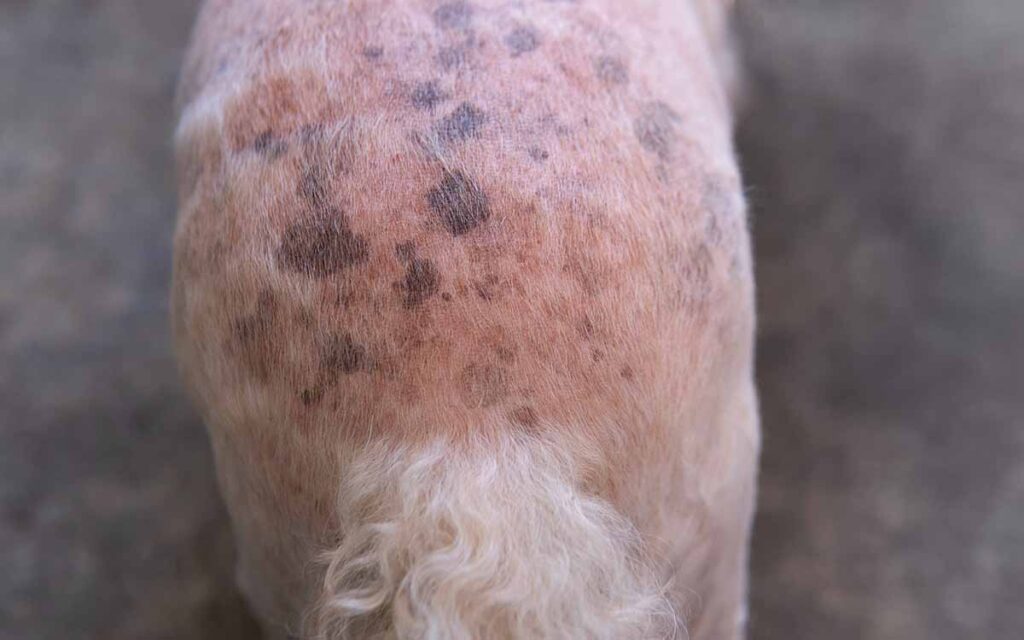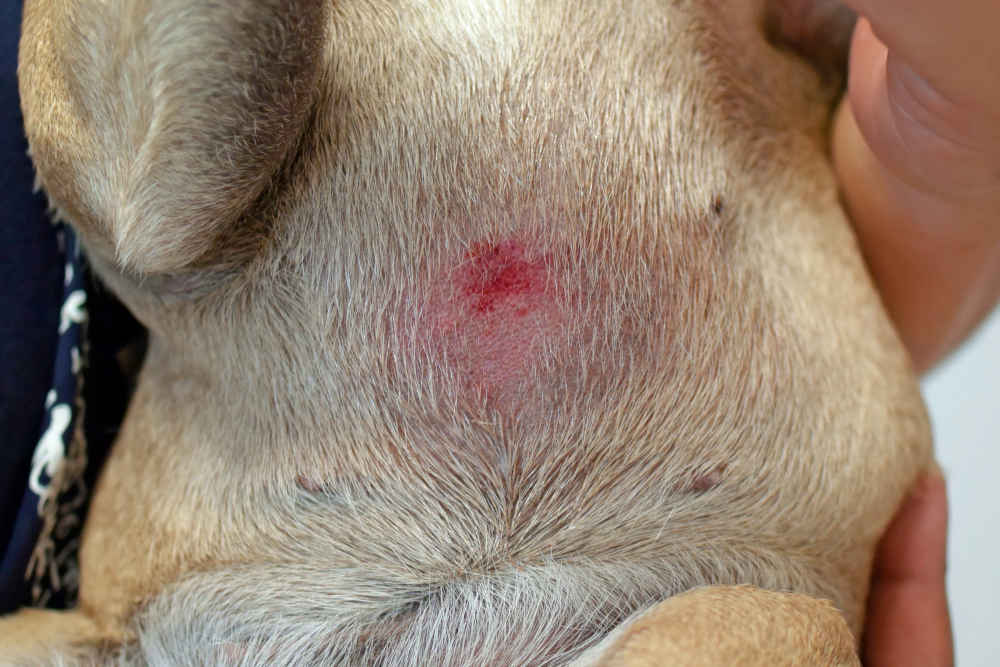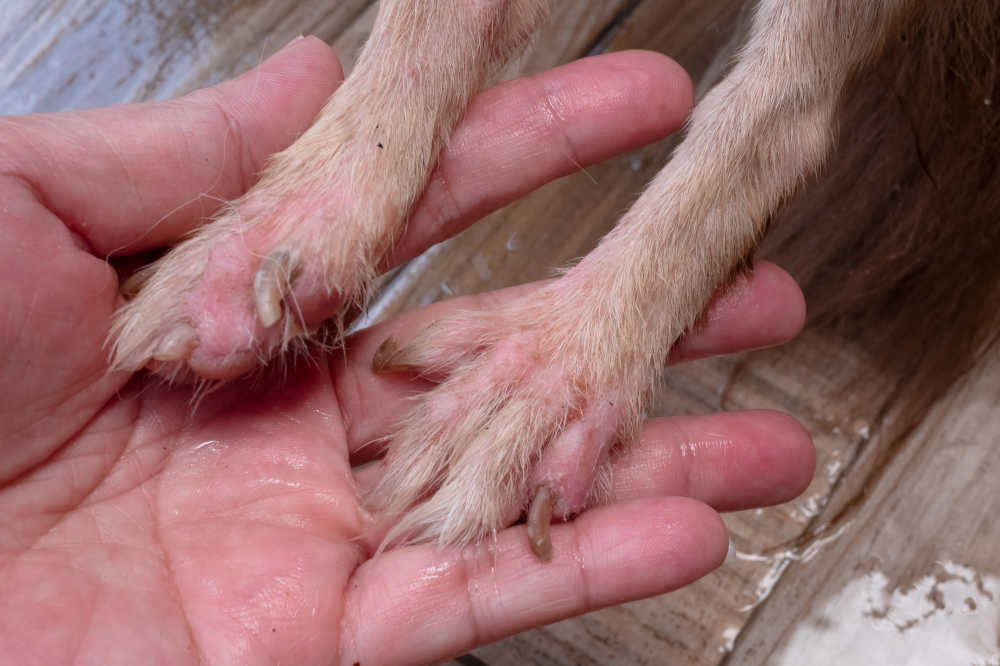
This article was updated on December 6th, 2022
Heat rash is an issue I encounter fairly regularly in my practice, especially in the summer months. Many owners like to get outdoors with their canine companions when the sun is beaming down. However, many owners don’t take into account the effects that extreme heat can have on dogs and, as a result, many dogs are rushed to their veterinarians for emergency treatment after they overheat.
Unfortunately, this is still an issue that many owners are oblivious to, but this article aims to educate owners and will go into detail on how to know if your dog has heat rash and what you can do at home to help your dog.
What is Dog Heat Rash?
Prolonged exposure to very hot temperatures results in irritation to the skin and changes in the skin’s appearance. Dogs don’t sweat in the same way humans do and instead regulate their body temperature through panting; their thick coats can leave them susceptible to the effects of overheating. The main cause of heat rash in dogs is overexposure to heat or direct sunlight.
Below are the most common symptoms seen with heat rash:
- Red inflamed skin
- Itchy skin – persistent scratching and licking
- Ulceration, pimples and/or pustules on the skin
- Scabbing of the skin
- Bleeding
- Smelly skin
The effect of extreme heat can also have a negative impact on your dog as a whole, resulting in:
- Lethargy and feeling unwell
- Dehydration.
Damage to the skin can also result in secondary bacterial or fungal infections, further exacerbating the issue.
Heat rash affects dogs of all shapes and sizes, but overweight dogs or dogs with very wrinkly skin are particularly vulnerable. Dogs with more skin folds such as shar peis, bulldogs and pugs are often at a higher risk of developing heat rash.
What Does Dog Heat Rash Look Like? (With Pictures)
Heat rash can take various forms depending on the severity and area of the body affected. The general appearance is that of red, inflamed and sometimes raised skin such as that shown in the photos below:
1. Mild Heat rash – slight redness to the skin and blotchy appearance. Mild cases of heat rash may be of little concern. If your dog’s skin is only mildly reddened and they are only scratching at themselves occasionally then the problem will likely resolve itself within a few days, especially if you implement some of the home remedies we will cover later in this article.

2. Moderate heat rash – more red appearance, irregular and uneven skin surface, as seen on the picture below:

3. Severe heat rash – bright red, ulcerated skin often with hair loss and signs of secondary bacterial infection.
If your dog has very red, ulcerated skin and they are frantically scratching at themselves then this poses a concern and they should be taken to the veterinarian immediately. Signs of infected skin such as pustules or a foul smell are also a reason to seek veterinary intervention.
If your dog is unwell in any other way, such as showing signs of lethargy, vomiting and dehydration then they may also have heat stroke alongside a rash. This should be treated as an emergency and you should take them to the vet immediately. Below is a picture showing a severe case of heat rash on a dog:

4. Focal heat rash – sometimes heat rash can occur in a more local, specific area of skin rather than affecting the whole skin more broadly.

How to Tell if Your Dog Has a Heat Rash
While it can be difficult to say for sure if your dog has heat rash, the sudden appearance of any of the symptoms above shortly after spending time in a hot environment makes heat rash quite likely. Mild cases of heat rash may respond to applying a cool towel or soothing cream to the affected areas of your dog’s skin – if they improve then it’s likely that your dog is suffering from heat rash.
4 Steps You Can Take at Home to Help Your Dog
While severe cases of heat rash will require veterinary attention, there are a few steps you can take at home to help alleviate the symptoms of heat rash:
- Put your dog somewhere cool. Avoid direct sunlight and heat and try to cool them down as much as possible. Placing them in a bath of cool water or directing a fan to blow cold air in their direction may help.
- Apply a cool towel or cold compress to the affected areas. The sooner you can do this, the more effective it will be. This will help to cool down the affected areas of skin before symptoms worsen.
- Apply aloe vera to the affected areas. This can be either directly squeezed from the plant or in the form of a soothing aloe vera cream (See this cream on Amazon). Other soothing creams may work too.
- Call your vet: if no improvements are seen after 24-48 hours, call your vet: delaying veterinary treatment could endanger your dog and make the issue a lot worse than it is now. Even mild cases of heat rash can turn into a more complex skin infection or irritation.
Is Dog Heat Rash Serious? Is My Dog Suffering?
Mild cases of heat rash are not likely to cause your dog any more discomfort than a subtle itchy sensation, which can be treated by the remedies we will cover in this article. However, more serious cases of heat rash where the skin is very inflamed and damaged are likely to cause extreme discomfort to your dog. Itching and licking at affected areas results in more damage and a vicious cycle develops. Damage to the outer layers of the skin also allows bacterial or fungal infections to take hold.
Exposure to extreme heat can be harmful to your dog in other ways too. Aside from a rash developing on the skin, dogs can develop heat stroke. This is a serious condition in which your dog overheats, becomes dehydrated and lethargic. Therefore, it’s important to not only be aware of symptoms of heat rash but also heat stroke as often the two come hand in hand.
Can My Dog Recover from Dog Heat Rash Without Vet Treatment?
Your dog may be able to recover from mild cases of heat rash if you implement the steps above. However, if the symptoms are persisting more than 48 hours or are getting worse then you must take your dog to see the vet immediately as it’s likely that they require stronger treatment.
When to Call Your Veterinarian
If your dog has more than a moderate form of heat rash (based on the pictures above), or if you think there are signs of skin infection such as pustules or a foul smell then veterinary intervention is required. A heat rash that isn’t responding to the home remedies discussed above will also require help from your vet.
It’s also important to be aware of the symptoms of heat stroke as these conditions often go hand in hand with a dog that has overheated. Any signs of lethargy, dehydration, vomiting or even seizures should ring alarm bells and you’ll need to take your dog to see the vet straight away.
How Can the Vet Help with Dog Heat Rash? How Much Will It Cost?
For those more severe cases of heat rash that haven’t responded to home remedies then the vet can help out.
Vet Diagnosis
Diagnosis of heat rash is challenging because it can look very similar to other skin diseases such as allergic dermatitis and parasitic infection. The diagnosis is made by ruling out other causes and by assuming heat rash is the cause based on the information you provide the vet, such as whether your dog has spent a lot of time in warm weather recently.
Various skin tests can be performed if necessary, such as skin scrapes and hair plucks to look at the structure of the skin under the microscope and determine a cause. However, for the most part treatment can be started without too many tests being performed. The treatments of heat rash are very similar to other skin diseases.
Vet Treatment
Your vet will likely provide some sort of anti-inflammatory medication to your dog to help reduce the redness and irritation in his skin. This may be in the form of oral steroids or topical steroid creams such as hydrocortisone.
In cases where secondary bacterial or fungal infection is suspected, your vet will likely dispense antibiotics or antifungal treatments – these may be in the form of topical creams or oral medications.
The cost of treatment will depend on the severity of the rash present but most topical treatments and steroids aren’t overly expensive. Expect a bill between $50-200 depending on how bad your dog’s rash is and how well your dog responds to treatment.
What you Should Know Before the Vet Visit
There’s a few questions that your vet will likely ask you should you visit for an appointment and it helps to have the answers prepared in advance. Questions they may ask include:
- Has your dog been exposed to extreme heat and/or direct sunlight recently? If so, for how long?
- How long has your dog had a rash?
- Is your dog itching or chewing at themself?
- Is your dog displaying any other symptoms? Are they well in themself?
- Have you tried any treatments at home for your dog’s rash?
Prevention Methods for Dog Heat Rash
Prevention of heat rash revolves around reducing your dog’s exposure to extreme heat and direct sunlight. Keep your dog well hydrated and cool, especially on very warm summer days. Only take your dog out for walks early in the morning or late in the evening when it’s warm outdoors and make sure they have plenty of water available.
Typical Recovery Time/Prognosis for Dog Heat Rash
Dogs with heat rash typically make a quick recovery if treatment is started early. Dogs with mild to moderate heat rash will often show a marked improvement in a few days, more severe cases of heat rash where secondary bacterial infection of the skin is present may take a couple of weeks.
Generally heat rash isn’t life-threatening but the other effects of heat exposure can be. Should you notice your dog appearing unwell and lethargic then seek veterinary advice immediately as they may be suffering from heat stroke.
What Looks Like a Heat Rash, but is Not a Heat Rash
The symptoms listed above are not exclusive to heat rash and many other skin conditions can look very similar. For example:
1. Allergic dermatitis – inflammation of the skin due to an allergic reaction – can look very similar to heat rash; redness, pimples, scratching etc are all symptoms of allergic dermatitis and so it can be easy to confuse these conditions.

2. Hot spots. Hot spots, technically known as acute moist dermatitis, are red, inflamed areas of skin that can seem to appear overnight. These spots may occur anywhere on a dog but are most common behind and under the ear, legs, and on the hips. The area will be moist and typically have some purulent oozing. Often there is matted fur covering and hiding the hot spot. Learn more about hot spots in dogs.

While either of these conditions could be the cause of your dog’s recent rash, if your dog has recently spent time outdoors in the heat then a heat rash is very likely.
Dog Heat Rash FAQs with the Vet
Where is Heat Rash Most Often Seen?
Heat rash tends to affect the areas of the skin where it is thinnest, most sensitive and hairless as well as areas when the skin is folded on itself. The most common areas include, but are not limited to:
- belly,
- groin, and
- armpits.
How Does a Heat Rash Look on a Dog?
Heat rash can take many forms depending on the severity of the condition. It often appears as a reddened, ulcerated area of skin. The skin may appear uneven on the surface or even have pustules present indicating a secondary bacterial infection.
What is the Fastest Way to Get Rid of a Dog Heat Rash?
Cool your dog down as soon as possible and apply aloe vera cream.
How Long Does a Dog Heat Rash Last For?
This depends on how severe the case of heat rash is but usually the symptoms will subside within a week or two, sooner if the correct treatment is started.
Does Vinegar Help a Dog Heat Rash?
While vinegar diluted 50/50 with water may help, I wouldn’t recommend it as it could be too harsh on your dog’s skin, especially if they have sensitive skin.
Does Baking Soda Help a Dog Heat Rash?
Baking soda when combined 50/50 with water to form a thick paste can have a soothing effect when applied to your dog’s skin. However, this probably won’t be very effective for severe cases of heat rash.
Does Benadryl Help a Dog Heat Rash?
While Benadryl may be useful in treating a rash, it will likely only be effective in cases where the rash is caused by an allergy since this medication is an antihistamine. Benadryl will likely have little effect for dogs with heat rash.
Can I Put Neosporin on My Dog’s Heat Rash?
Neoporin is an antibiotic ointment that may be of some benefit in preventing bacterial infections in dogs with heat rash, however it is no substitute for proper veterinary intervention.
Should You Moisturize a Dog Heat Rash?
Yes, keeping a dog’s skin moistened when they have heat rash is important in preventing any further damage to the skin.
Disclaimer: This website's content is not a substitute for veterinary care. Always consult with your veterinarian for healthcare decisions. Read More.


Be the first to comment